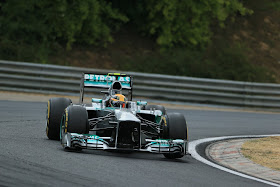Fernando Alonso is an odd one, isn't he? While his place at least somewhere within the sport's pantheon of great drivers seems assured by now, citing single astonishing performances from his career - drives from the Gods, if you will - is a little tricky.
With many of the other F1 greats such drives can roll off the tongue: Fangio at the Nurburgring in '57, Moss in Monaco '61, Clark in Monza '67, Senna in Donington '93, Schumacher in Hungary '98... Even within Alonso's 2012 campaign, one which only the obdurate would suggest was not one of the most persistently impressive seasons from anyone ever, naming individual performances of that rank is difficult, maybe Valencia aside. His year's effort was more based on relentless brilliance, a 9.5 out of 10 performance just about every time.
 |
Fernando Alonso in the 2006 season
Credit: Kamalsell / CC |
But there is another drive in Alonso's career that we can point to as being up there, that of Hungary in 2006. Now, you'd be forgiven at this point for feeling rather bewildered, as it's not a drive talked about much. Indeed, it even seemed that the drive's quality had been forgotten in certain quarters before the race had even finished. Perhaps because it was a drive that didn't last all of the way to the chequered flag (and F1 is a results business), perhaps as well it reflects that the focus after the race was elsewhere (for one reason in particular). But whatever the case these do not begin to diminish the quality of Alonso's performance that day; it can absolutely be considered as a forgotten marvel.
Ah, Hungary. For much of its now quarter century-plus history as an F1 venue its Hungaroring has not won many popularity awards. Yes, it's always attracted a numerous, multi-national crowd; it's the layout that's been the problem. It arguably was the first of the new generation of tight, torturous tracks that gradually replaced the classic high-speed challenges such as the Österreichring and Zandvoort on the calendar. 'Monaco without the houses' was a polite description made in the circuit's early days. Nigel Roebuck noted that when the fraternity first laid eyes on the 'purpose-built' venue in 1986 'we swiftly concluded that part of that purpose had been to prevent motor racing. Tight and sinewy, it amounted to a prescription for soporific grands prix.' Jabby Crombac was less restrained, as when one year he was asked by a local how the track could be improved he replied 'Dig it up'.
Yet somehow, in addition to the Michael Schumacher drive already mentioned, it has developed a partial knack of being the scene of great drivers putting in great drives. And so it was in 2006.












.JPG)




